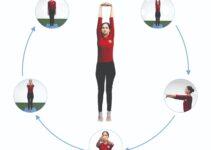Dolphin Pose Yoga is excellent for stretching and strengthening various parts of the body, including the shoulders, back, hamstrings, and calves, while also providing a moment of relaxation and focus on your breath.
Dolphin Pose Yoga Procedures
- Start in the Table position, which is a tabletop-like position on your hands and knees.
- Lower your forearms on the surface, tuck your toes under, and try to lift your hips up toward the ceiling.
- Spread your fingers wide apart, with the middle finger facing forward. Place your palms shoulder-width apart on the surface. Press your forearms, fingers, and palms firmly into the floor while continuing to lift your hips up and back.
- Keep your feet hip-width apart with the toes facing forward. Press your heels into the floor, which will create a stretch in the back of your legs. Your legs can be either straight or slightly bent at the knees to maintain a flat back.
- Now, allow your head and neck to hang freely from the shoulders, and you can let your forehead rest on the floor if it’s comfortable.
- Breathe deeply and hold this pose for 2-6 breaths. Focus on maintaining a straight and elongated spine while you breathe.
- To release the pose, you can either bend your knees and lower your hips back down to the Table pose or come all the way down to Child’s Pose, a resting yoga position where you sit back on your heels with your arms extended forward and your forehead resting on the floor.

Dolphin pose
Dolphin pose Yoga benefits
- It helps to open the shoulders and upper back.
- Helps to lengthen the spine.
- Stretches the hamstrings and builds upper body strength.
- It is good to stimulate the nervous system.
- Improves headstand.
- Helps to strengthen the abdominal muscles.
Dolphin pose Yoga contraindications
It has following limitations.
- It shouldn’t be performed during chronic arm, back and shoulder injury.
- Avoid in case of inflammation.
- High blood pressure
- Glaucoma
- Recent stroke
Different Names
- Half Peacock Feather
- Peacock Feather Preparation
- Ardha Pincha Mayurasana
- Forearm Adho Mukha Svanasana
Variations and Modifications
Start in Dolphin Pose
- Begin in a forearm plank position by placing your forearms on the mat, shoulder-width apart.
- Keep your palms facing down and your fingers interlaced.
- Now, press your hips upwards towards the ceiling, creating an inverted “V” shape with your body.
- Engage your core and keep your head relaxed, looking between your forearms.
Transition to Forearm Plank on Inhale:
- As you inhale, walk your feet closer to your hands, bringing your body into a forearm plank position.
- Ensure your body is in a straight line from head to heels.
- Maintain a strong core and engage your glutes to support your lower back.
Transition back to Dolphin Pose on Exhale:
- On the exhale, return to the Dolphin Pose by walking your feet back to their original position.
- Lift your hips towards the ceiling and maintain the inverted “V” shape.
Prepare for Forearm Balance and Headstands:
- Once you are comfortable with Dolphin to Forearm Plank transitions, you can prepare for more advanced poses like Forearm Balance and Headstands.
- Start by lifting one leg at a time to practice balancing on your forearms.
- Gradually work on shifting your weight and finding your balance point, but be cautious and use a wall or a spotter for safety.
Add Dolphin Press-Ups:
- To challenge yourself further, incorporate Dolphin press-ups.
- Interlace your fingers, bring your chin closer to your hands, and then press through your forearms to lift your upper body slightly.
- Lower yourself back down and repeat the press-ups to build upper body strength.
Turbodog Pose:
- For Turbodog pose, lift your elbows slightly off the mat while in Dolphin Pose.
- Keep your forearms parallel to each other.
- This variation intensifies the engagement of your shoulder and arm muscles.
Preparatory poses
- Plank Pose
- Uttanasana
- Table
- Low Plank
- Down Dog
- Sphinx
Follow-Up Poses
- Salabhasana
- Peacock
- Child
- Down Dog
Top facts about Dolphin pose Yoga
- Sanskrit Name: Ardha Pincha Mayurasana.
- It is pronounced as “ar-duh PIN-chuh my-YUR-AH-sah-nah”.
- The pose level is Beginner.
- Drishti: Nasagre (Tip of the nose).
- Pose Type: Core, Forward Bends, Inversions, Strength
Anatomy of Dolphin pose
Dolphin pose affects the muscles like arms and shoulders, lower back, biceps and triceps, Abs, Gluteus, Hamstrings and Quadriceps.





